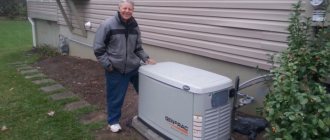| Place | Name | Characteristics in the rating |
| The quietest diesel generators |
| 1 | Fubag DS 3600 | Best price for a diesel unit |
| 2 | Pramac P 4500 | The most reliable generator. Low volume operation |
| 3 | Geko 7801 E-AA/ZEDA | Diesel generator for domestic use |
| 4 | ENERGO ED 8/230 H | Powerful, high quality device |
| 5 | TCC SDG-7000 EH3 | Three-phase generator 380 volts |
| The quietest gasoline generators |
| 1 | Honda EU10i | The best low noise gas generator. The quietest |
| 2 | Fubag TI 800 | Long battery life |
| 3 | Huter HT950A | Most popular manufacturer |
| 4 | PATRIOT GP 1000i | The best ratio of price and quality |
| 5 | ELITECH BIG 1000R | Large fuel tank capacity |
The quietest diesel generators
A diesel generator is rarely used for domestic purposes. Among them there are no compact installations that produce only a kilowatt. As a rule, these are powerful machines, where the minimum threshold is 3 kW. At the very least, two. A diesel engine is considered more economical, practical and durable. All other characteristics being equal, it is capable of delivering much more energy compared to its gasoline counterpart. But its sound level will be higher. The lowest noise models have a value in the region of 70-80 units. Well, a silent generator is still fantastic.
One or three phases?
This question is as important as the previous ones, because a single-phase and three-phase generator are completely different devices that have their own conditions for operation and application. There is simply no answer to the question of which is better. Each individual situation has its own variant.
Photo: donelektrik.ru Single-phase network diagram
- If there is not a single three-phase consumer in the house and the centralized power supply is supplied through one line, the conclusion is clear: a single-phase generator is needed.
- A single-phase unit is also needed when three lines are connected, but only one needs to be reserved (if, for example, a heating system, refrigerator, pumping station, etc. is connected to it).
- If you have single- and three-phase consumers, you can go in two ways: buy two power plants of different designs or still one three-phase, but be sure to ensure that the loads between the lines are distributed evenly.
Photo: donelektrik.ru Three-phase network diagram
If 3 phases , there are also two options:
- Buy a 3-phase power plant and a 3-phase automatic transfer switch (automatically entering a reserve, which will automatically turn on the generator when the power in the centralized network disappears). In this case, it is necessary to lay separate lines in which a uniform distribution of loads between them would be provided, and their sum would not be more than a third of the total power of the unit (if the generator is designed for 15 kW, not more than 5 kW).
- 1-phase generator and 3-phase ATS in the absence of three-phase consumers. In this case, if necessary, the automation will connect all the phases of the network with the generator, and the unit will simultaneously power each of them. At the same time, you no longer have to worry about ensuring that the loads are evenly distributed.
It is important to consider when connecting a three-phase unit to the network that the maximum permissible phase imbalance is 25% of the power. If this rule is not followed, the generator will simply fail.
The quietest gasoline generators
In most cases, a gas generator operates quieter than its diesel counterpart, but even here the noise level does not fall below 55 dB. And then, only inverter installations, which are initially quieter, have this indicator. The inverter housing contributes to this. Completely closed, it partially conceals the sounds produced, although the exhaust noise cannot be removed anywhere, and it is this that is the main source of sound. In our rating we will consider devices with a power of up to 3 kW, but the quietest ones have a value of 1 kW and lower.
How to choose a device for your home?
When choosing a generator, consider the following criteria:
- engine type - the units are equipped with two- and four-stroke engines, the advantage of the latter is to ensure longer operation of the generator;
- phasing - to supply energy to household appliances and power tools, a single-phase generator is sufficient; three-phase ones are necessary for more powerful devices (welding, pumps, etc.);
- engine power - there are household devices with a power of up to 5.5 kW, semi-professional 10 kW, professional 30 kW;
- duration of operation - depends on the size of the fuel tank, generators with a capacity of 20 liters operate up to 13 hours without refueling;
- weight of the device - ease of use and transportation depends on it;
- starting device - there are models with manual start and with an electric starter, the latter start automatically in the absence of a central power supply;
- cooling - most mini-power plants are equipped with an air-type fan;
- noise level - up to 72 dB is considered comfortable;
- protective casing - certain models are equipped with a special casing that protects the housing and control panel from mechanical influences.
Why consider the starting current coefficient
This indicator reflects the power of the electrical device that occurs at the moment the engine starts for a fraction of a second after starting. The inrush current coefficient is expressed as a multiplier number (specified in the operating instructions for the specific device). It is denoted as cos φ (cosine phi). It is by this number that the current increases for a fraction of a second during the startup of the electrical appliance.
| Name of equipment | Rated power, W | cos φ | Starting power, W |
| Fridge | 150 | 3,5 | 525 |
| Microwave | 900 | 2 | 1 800 |
| Air conditioning equipment | 1 000 | 3,5 | 3 500 |
| Vacuum cleaner | 1 600 | 1,5 | 2 400 |
| Washing machine | 2 000 | 1 | 2 000 |
| TV | 90 | 1,1 | 99 |
| Water pump | 400 | 3 | 1 200 |
| Laptop | 50 | 2 | 100 |
It is important to remember that cos φ of devices (light bulbs, heaters, electric stoves) that spend energy only on heat is equal to 1. This means that when turned on, their starting power does not increase.
The more powerful the equipment, the greater the load capacity it has, and, accordingly, its cosine phi index is higher. Power tools have a fairly high cos φ: a welding machine - 4, a concrete mixer - 3.5.
Top models from 1500 W
SPEC IG2000 (1500 W)
High-quality Russian equipment, which is reliable and well assembled. In addition, the maximum power of the product is 1.9 kW, which makes it possible to connect various household appliances. The engine life is 2000 hours, but this is not so much, but if you use the product correctly and constantly care for it, the design will last longer.
Engine power – 3.1 hp. The noise level is low (50 dB), everything is saved by a special soundproof casing. But the mass of the product here is slightly higher than that of the previous version and is 19 kg. The warranty period is 12 months, which is normal. Also included is a muffler. There is built-in overload protection, which makes use safer.
Sold at a price: from 33,000 rubles.
SPEC IG2000 (1500 W)
Advantages:
- The presence of a soundproof casing;
- High strength indicators;
- Efficiency;
- Low noise level;
- Power;
- Reliability.
Flaws:
- Engine resource.
Ergomax ER 2000 i (1600 W)
A reliable model, characterized by efficiency and easy operation. The maximum power reaches 2 kW, which makes it possible to connect various household appliances. Only gasoline is used as fuel. There is good air cooling that prevents the motor from overheating. The noise level is 58 dB, which is comparable to some refrigerators. It has two sockets for 220 V and one for 12. The total weight of the structure is 25 kg, so the help of a second person will be required during transportation.
Sold at a price: from 39,000 rubles.
Ergomax ER 2000 i (1600 W)
Advantages:
- Value for money;
- Reliable casing;
- Sufficient strength;
- Small dimensions;
- Air cooling.
Flaws:
- Not found.
ENERGY EB 2.5/230-Y (2000 W)
One of the best models because it has a noise level of only 38 dB, which makes it possible to easily install the product inside the house. Only before this you should organize the correct hood. There is effective air cooling that will prevent the engine from overheating during operation. Fuel consumption is 750 ml per hour, which is a fairly high result. The weight of the product is 38 kg, so it is better to find a place for it in advance, since it will be difficult to constantly move the structure.
Sold at a price: from 49,500 rubles.
ENERGY EB 2.5/230-Y (2000 W)
Advantages:
- Maximum power – 2.5 kW;
- Assembly;
- Reliable air cooling;
- Noise level – 38 dB;
- Capacious fuel tank;
- Strength.
Flaws:
- Not found.
Solar panels
Nowadays, solar power sources are becoming increasingly popular. The essence of such a source is simple - there are semiconductor photocells in which an electric charge is generated when sunlight hits them.
The amount of energy generated directly depends on the area of the photocells, so they are collected in panels.
Panel with an area of 1 sq. m. capable of delivering 100 watts of power with a voltage of 20-25 V.
To fully provide the house with electricity, the area of the panels must be large.
Among the positive qualities of such a source of electricity is its durability, complete environmental friendliness, and noiselessness.
The panels require minimal maintenance, and the electricity they generate is completely free and accessible.
But there are also disadvantages. To provide the required amount of electricity, the area of the panels can reach significant sizes, which still need to be positioned correctly.
This energy is fickle. On sunny days the panels will work at maximum output, but there are also cloudy days. Therefore, the total amount of generated electrical energy depends on how many sunny days a year are in the region where the house is located.
Another drawback, and a significant one, is the cost of the panels. The price for each Watt of generated energy is now approximately $1.5, that is, only for panels generating 1 kW of electricity you will have to pay $1.5 thousand. You will also need to buy the rest of the equipment necessary for the system to operate.
Also read how to make solar-powered lighting for your garden.
Features of connecting to power line networks
It is now difficult to imagine comfortable housing without electricity. Thanks to it, the home is illuminated, heated, food is cooked, and water is heated. It’s just not always possible to provide electricity to your home, especially if the house is located far from the city.
Many owners of country houses and summer cottages, especially if they are located far from civilization, have to resolve the issue of energy supply at home.
The most common solution is to connect the house to power transmission lines, but they are not available everywhere or the nearest line is located at a considerable distance from the house.
In this case, providing electricity to your home can be very expensive. After all, you will have to coordinate issues on the supply of this energy source with the relevant authorities, pay for the installation of a substation and power line supports for connecting to the house.
And what’s especially unpleasant is that the equipment purchased, and at a considerable cost (substation, wires, supports), will be transferred to the balance of local energy networks, that is, they will be the owner of everything, and the owner of the house will also have to pay for the supply of electricity.
Therefore, for many, this option may become impractical, quite troublesome and expensive.
Determining the Best Energy Source
Choosing an alternative energy source for autonomous power supply to a residential building is a very important and responsible moment that requires a serious approach.
The most popular and most common options include:
- generators running on diesel fuel or gasoline;
- solar panels;
- batteries of large volume and power;
- hydroelectric systems;
- wind energy converters.
Each source has its own unique characteristics and features. Owners should familiarize themselves with them in advance and, based on this information, determine the best option for a system that can satisfy all the electrical needs of a private residential building.
The importance of power reserve
In order for the mini-power plant to function optimally, the load on the alternator should be no more than 80% of the rated power. Prolonged use of the generator set at its maximum capacity has a negative impact on its operating time (it is simply reduced). Therefore, it is important to create a power reserve.
When calculating the productivity of a mini-power plant, you need to not only take into account how many kW the total power of the equipment operating for at least 5 minutes will be, but also add 10–30% to this number. If the generator is used as a backup power source for the home, then a reserve of 10–20% will be sufficient. But, for example, for a diesel alternator providing power to a large construction site, it is better to increase the power reserve.
If you do not take this point into account, you may encounter an overload of the generator set and failure of its structural elements to operate. If there is a good power reserve, this will allow the house owner to connect additional equipment to the alternator that was not provided for.
Popular manufacturers
Choosing a brand of equipment is one of the most important tasks. Among the most popular are
- Honda , which is distinguished by high and stable production quality, as well as the ability to select equipment for difficult working conditions, low noise levels, easy starting, good traction and power performance.
- Kipor is one of the highly reliable Chinese brands with a large range of gasoline and diesel units, which is in demand due to its relatively low cost and is perfect for use at home or in the country.
- Huter is a brand that appeared on the Russian market relatively recently and is distinguished by its low cost, reliability and stability, and a wide range of models, including gas units.
- Zubr is a Belarusian brand that is on par with the world's leading brands at an optimal price level.
Hyundai , SDMO , Wilson , DDE and FUBAG are also widely represented on the market . It is also worth paying attention when choosing a specific model and manufacturer to the availability of a developed network of technical service centers for this equipment in order to protect yourself from lengthy searches for the necessary specialists and spare parts.
Batteries for autonomous systems
The principle of operation of the battery is clear and simple. As long as there is electricity in the central network, the batteries are charged from the outlet and accumulate resource in their blocks. Solar batteries function in a similar way.
When energy supplies are interrupted, the modules, through a special inverter installation, supply electricity to household appliances and various home systems.
When choosing a battery to create a backup electrical system in a residential building, it is worth determining which devices and modules of household appliances must be connected in the event of a lack of light. By adding together their base power, you can get a number indicating the capacity of the battery, capable of powering the most necessary devices
They are not suitable for constantly providing a living space with electricity, but they will cope with the role of a backup complex perfectly.
The following article, which is entirely devoted to this interesting issue, will introduce you to the best developments for organizing alternative energy in a country house.
Kinds
Generators come in several types.
By fuel type
The generator can run on diesel, gasoline or gas. There are also models that include two systems at once, which are designed for different types of fuel. The type of fuel used will not affect the final output of the generators.
Diesel generators
Diesel generators are designed for uninterrupted autonomous operation.
Diesel generator
Despite the existing disadvantages in the form of noise and sensitivity to temperatures, it has become widespread due to its efficiency, because diesel is cheaper than gasoline, and refueling is much easier than its gas counterpart.
Gasoline
The most budget models run exclusively on gasoline. But this comes with a major disadvantage - the cost of heating, since gasoline is extremely expensive compared to other types of fuel. But a model with such a fuel system is perfect for homes where the use of a generator is rare.
Gas generators
The high price is compensated by the low cost of gas. Fuel can be supplied directly from the main line, eliminating the need to constantly replace cylinders. Models may differ, since the main line generator is not designed to operate on liquefied bottled gas.
You might be interested in this: Interval period for electric meters
Combined
If the buyer does not know which electric generator to choose, then he can use combined versions.
Combined generator
Such devices include two fuel supply systems at once, between which you can switch at any time. Good models will cost more than gas ones due to the need to combine fuel types.
Depending on current and power output
Electronic devices installed in the house have different parameters. Some cannot tolerate even minimal voltage drops, while others operate regardless of the type and characteristics of the supply generator. To select a suitable power supply, you will need to decide on the type of alternator that is installed in the device.
Synchronous generator
A synchronous generator includes a rotor, a starter and a control unit. The device works in such a way that the motor rotor rotates, which causes the magnetic field to rotate. The output power will depend on the rotor speed.
Synchronous generator device
To avoid changes in voltage during improper operation of the device, the generator is equipped with a control unit. This is the only way to achieve the required accuracy of power output.
Most models are equipped with this method. This allows you to obtain high-quality current, and the device itself will be protected from voltage surges. But to maintain the operation of such a device, you will need to constantly replace the brushes and clean the entire generator.
Asynchronous
Models of this type consist of a starter and a rotor. The starter design is identical to that of synchronous models. There is no connection between the rotor and the rotor via electricity; it is impossible to control voltage and current.
Asynchronous models are considered cheaper due to their structure. The advantage is the closed housing, which is why the device can be used even in rooms with a lot of dust.
Asynchronous generator device
The generator's resistance to short circuits allows it to be used for welding machines. If you need to connect devices with electric motors or split systems to the network, then it is better to pay attention to power sources with a different method of generating current.
Inverter
This type of generator sends current through the network through a rectifier and battery, rather than directly like other types. They are considered the best models on the market due to their low noise level and output current characteristics. A negative aspect is the high cost of inverter devices.
A gasoline engine model is the best power plant for the home if the generator will be used for a minimum amount of time only as a backup power source. Diesel and gas models are purchased to obtain constant electricity in places of residence where electricity may be turned off for more than a day.
*Prices are current as of October 2022.
Principle of operation
An electric generator is a device for generating electricity. It can be used to power electrical devices.
- An electric generator can power devices in a private home during a power outage.
- However, it can also be successfully used where it will be an independent source of electricity.
- Such places would be, for example, a garage, workshop, garden or construction site.











